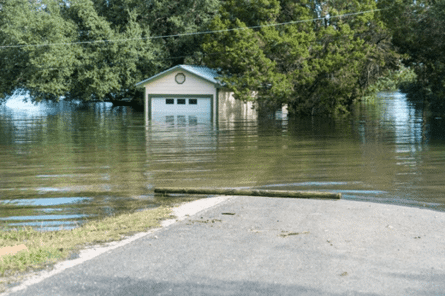Storm damage is one of the last things a homeowner wants to deal with. With heavy storms, high winds, and flooding, storms can cause mild to catastrophic damage to your home, including:
- Roof damage
- Water seepage
- Roof leaks
- Electrical hazards
- Flooded basements
- Mold growth
- And more
The professionals at ServiceMaster TEAM are committed to helping homeowners prevent further damage by performing thorough inspections of all affected areas. However, homeowners can also perform their own DIY storm damage inspections to gain an understanding of the scope of the damage, to learn which repairs must be performed to bring your home to pre-loss condition – and gain peace of mind.
Let’s explore six of the most common areas of your home that you should inspect for damage after the storm.
#1. Foundation
To start, the foundation of your home is one of its most important structural elements. If it fails, so does the rest of your home – with serious financial consequences.
When heavy accumulations of water reach your foundation during the course of a storm and afterward, the structural elements can become significantly weakened and could potentially fail if moisture exposure is prolonged.
To inspect your foundation, take a careful look along both the outdoor and indoor perimeter of your home for any signs of water seepage. Water can wash out the soil beneath the footings that hold up your home, leading to tilting and leaning. A few definite signs of tilting due to a damaged foundation are doors and windows that get stuck that ordinarily open with ease or cracks in interior walls.
Bear in mind that you should also look out for cracks and bulges in wood and concrete surfaces. This means that water has infiltrated the foundation and needs to be mediated quickly (especially before the winter, when it can expand and melt repeatedly).
Last, it’s important to re-check the foundation several weeks after the storm. Damage that may not have been immediately visible after the storm can manifest weeks later without warning.
#2. Electricity
Electrical damage can cause serious hazards to your home and pose a threat to life if subjected to storm damage. Therefore, every electrical component that has been below floodwaters or exposed to excessive moisture should be replaced as a best practice (even if they appear unaffected). Some of the most typical electrical components in your home to replace include outlets, switches, wiring, appliances, furnaces, and more.
Bear in mind that contaminants in the water can also damage sensitive electrical components by corroding connections, leading to sparks and shorts that may not be visible. Therefore, it may be necessary to consult a professional to perform a thorough assessment of the electrical storm damage in your home.
#3. Basement
Storm damage often leads to flooding, and flooded basements are a common occurrence – often in a relatively short time. After the waters have stopped rising, it’s important to remove any damp belongings, pump out any standing water, and dry the basement with fans to circulate moisture out of the space (often over the course of days).
#4. Exterior Walls
Severe winds and airborne debris can cause damage to the exterior walls of your home. Inspect the exterior walls of your home, including shingles, siding, window panes, and so forth. Even a minor loosening of these materials can cause leaks after experiencing storm damage, so be sure to reattach and recaulk all affected areas.
#5. Roof
As you walk around your property, check for missing shingles around your property, fallen tree branches, missing chimney flashing, or wet spots throughout your home (especially on the lower floors and ceilings). Because storms may bring driving rain, shingles may be pushed up temporarily, which can lead to temporary leaks that must be addressed (though the shingles may not need replacement).
#6. Gutters
Once the storm subsides, make it a priority to check your home’s gutters for any blockages or structural issues. Focus on checking for any loose or disconnected gutters that may have broken or malfunctioned, as well as signs that water sheared off the roof towards the foundation of the home.
For Storm Damage, Trust ServiceMaster TEAM
Whether you’ve performed a thorough DIY storm damage inspection of your home or need the services of a trusted professional, the professionals at ServiceMaster TEAM are here to help you every step of the way.
Our crews are here to assist you around the clock with every type of storm damage to perform the repairs necessary to restore your home. Call us to schedule your next storm damage inspection and repairs today!


